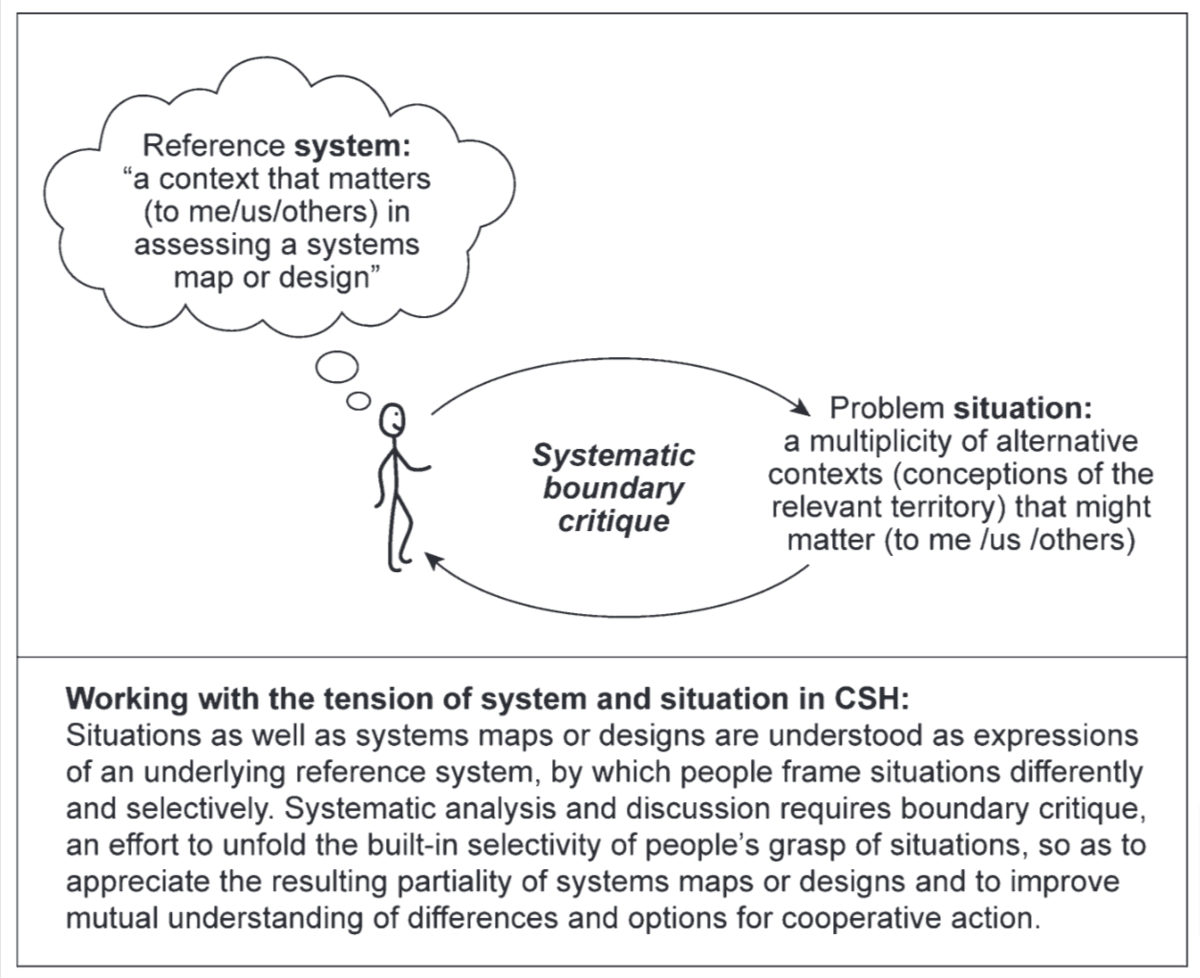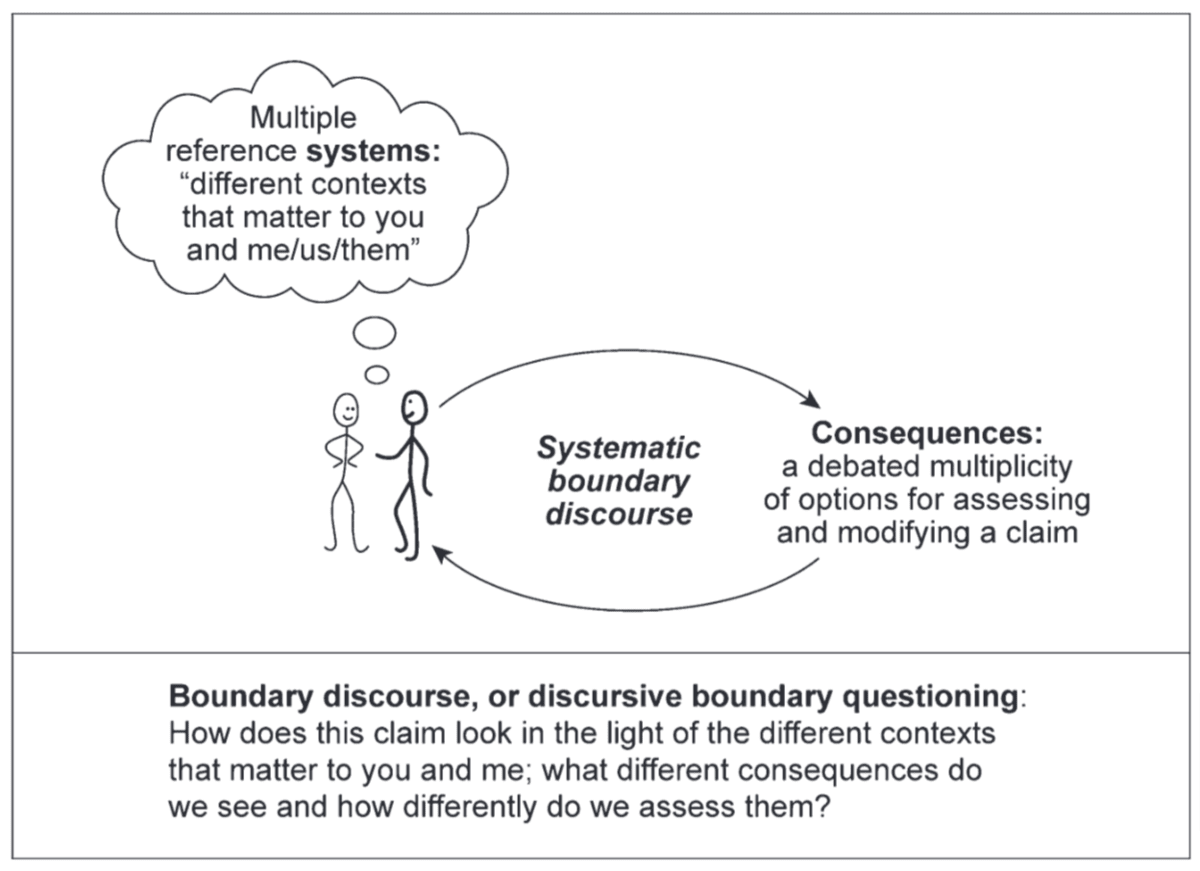TB871: Systemic boundary critique in CSH
Note: this is a post reflecting on one of the modules of my MSc in Systems Thinking in Practice. You can see all of the related posts in this category.
In my last post, I discussed Critical Systems Heuristics (CSH) and the way that its originator, Werner Ulrich, explicitly contrasts ‘systems’ (maps, designs, models) with ‘reality’. In a post before that, I compared the way that CSH and Soft Systems Methodology (SSM) deal with boundaries.
In this post, I’m going to explore the notion of CSH as a ‘reference system’ and go a bit deeper into what we talk about when we talk about ‘boundary judgements’. Note that I’m going to avoid getting sidetracked into philosophical discussions about whether using CSH means taking a realist stance.
CSH as a reference system
A reference system is ‘the context that matters when it comes to assessing the merits and defects of a proposition’
(Ulrich, 2000, p.251, quoted in Reynolds & Ulrich, 2020, p.266)
Unlike SSM and other approaches where the focus is more on boundary setting, the purpose of CSH is on boundary surfacing and review. By asking the 12 questions that serve as the boundary critique, we can be more aware and reflect on boundary assumptions.

Systemic boundary critique
Boundary critique is a process of ‘unfolding’ meaning that it involves making ourselves and others aware of the boundary judgements assumed in relation to the 12 boundary questions that I mentioned in my initial overview post about CSH. This is both a critical and self-critical approach (Ibid.).
In addition, questioning boundary judgements in a systematic way using the 12 questions helps highlight their adequacy in terms of relevance, justification, and ethical defensibility (Ibid., p.269). We’re required to analyse actual and possible consequences for all stakeholders and impacted groups, and to question what it means to ‘improve’ the situation. For whom? Based on what view of the world?
CSM makes explicit what are called four ‘sources of selectivity’ in a reference system: sources of motivation, control, knowledge, and legitimacy. Figuring these out helps answer the question “What exactly does the intervention claim to achieve and what are its built-in limitations, that is, the assumptions and conditions on which its ‘success’ depends?” (Ibid., p.271)
The idea isn’t to have a ‘perfect’ reference system with ‘correct’ boundary judgements. Rather, the aim of CSM is to highlight that boundary judgements are being made — and could be made differently.
Not unlike a good map, a good process of decision-making should make transparent the boundary judgements on which the claims to be decided upon rely. Likewise, it should shed light on how different these claims may look in the light of alternative boundary judgements. In short, when we subject
a claim to ‘boundary questioning’, we examine its consequences in the light of alternative sets of boundary judgements (those assumed in the claim as well as options).(Reynolds & Ulrich, 2020, p.275)
Reference systems, with their boundary judgements, serve as a way to reflect and engage in dialogue with others. Where are the areas of agreement or discrepancy?

There is likely to be some form of conflict or tension between reference systems which have been created by different individuals or groups. The reflection and discourse that arises from this is important. As West Churchman noted: “we have to maintain the contradiction or else we allow ourselves to be overwhelmed by the consistent” (Churchman 1968/79, p. 229/230, quoted in Reynolds & Ulrich, 2020, p.258).
Final thoughts
It’s important to note that boundary judgements are not set in stone. The whole point of them is to keep them under review and to see them as provisional and fluid. As such, we can talk about ‘systematic iteration’ of boundary judgements when new information comes along. Instead of merely trying to absorb this new information, and continue with our existing understanding of a situation, given the interdependence of boundary judgements, we may well need to revise our reference system entirely (Ibid., p.294)
References
- Reynolds, M. and Ulrich, W. (2020) ‘Critical Systems Heuristics: The Idea and Practice of Boundary Critique’ in Reynolds, M. and Holwell, S. (eds.) Systems Approaches to Making Change: A Practical Guide, 2nd edn, London: Springer-Verlag, pp. 255-300.
